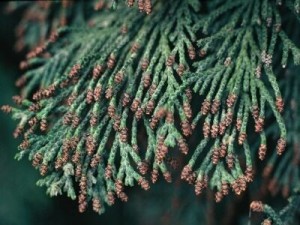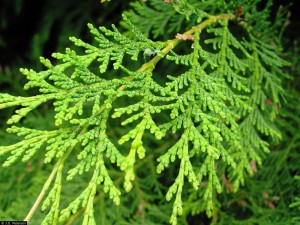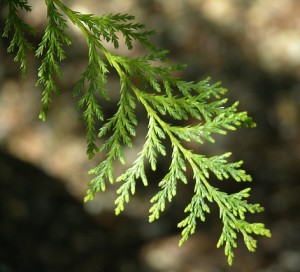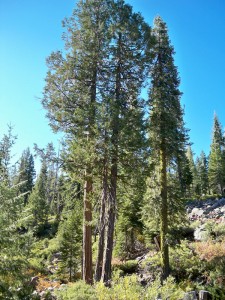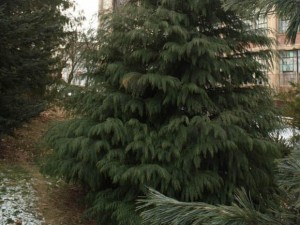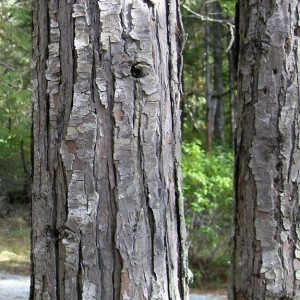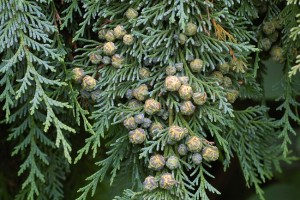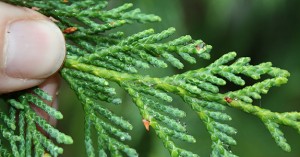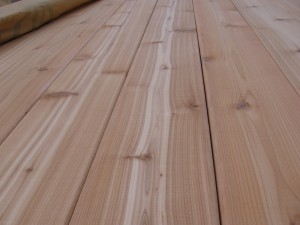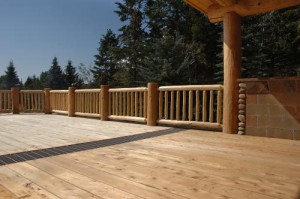Port Orford Cedar
Port Orford Cedar, widely known for its quality of wood and horticultural uses, is a conifer native to northwest California and southwest Oregon. It is found at an elevation of 4,900 ft (1,500 m) in the valleys of Klamath River.
It has feathery, bluish-green foliage with the pollen cones above and the young seed cones appearing below. Its scale-like leaves have white marks below, and they are found on flattened young twigs. Lawson Cypress, as it is commonly called in horticulture, has a scaly and fibrous bark that is reddish-brown in color.
Scientific Classification
| Kingdom | Plantae |
| Division | Pinophyta |
| Class | Pinopsida |
| Order | Pinales |
| Family | Cupressaceae |
| Genus | Chamaecyparis |
| Scientific Name | Chamaecyparis lawsoniana |
Quick Information
| Other Names | Pacific White Cedar, Pacific White Cypress, Port Orford Cypress, Oregon Cypress, Ginger Pine, False Cypress |
| Similar to | Extinct conifer species Chamaecyparis eureka, as revealed from its fossil foliage found on the Canadian Axel Heiberg Island |
| Size | Large trees; when matured, they may attain a height of over 197 ft (60m); their trunk diameter is 4-7 ft (1.2-2m), crown spread of about 5m |
| Leaves | 3-5mm long, arranged in crossed or intersected pairs; dead leaves are shed collectively in sprays |
| Cones | Globular form; have a diameter of 7-14mm with 6-10 scales; the young female cones are green while the mature ones are brown; the male cones are smaller than the female cones and have a red color |
| Tree Type | Evergreen |
| Shape at Maturity | Acute or acuminate at the apex |
| Distribution/Range | Coastal areas of northern California and southern Oregon; southern Coos County, northern Curry County in Oregon; Klamath, Illinois, Trinity, Sacramento, and Rogue River drainages; also in the Siskiyou and Mount Shasta region |
| Hardiness Zones | 5-8 |
| Lifespan | Long-lived; can survive over 350 years in the forest |
| Growth Rate | Moderate and consistent; annual height growth is 1.15 ft (0.35 m) |
| Growing Conditions | Humidity: High humidity at night, though some places in the valley are dry during the day; the coastal areas remain foggy Winter Conditions: Cold and wet winters; tolerant to a temperature of -15°C and a snowpack of 3-7 ft Summer Conditions: Warm and dry Rain: Moderate to high annual precipitation, typically 39-89 inches Sunlight: Full sunlight as well as partial shade Soil Requirements: Well-drained, moist soils; grows on sand dunes, the edges of intermittent streams, bogs, productive soils derived from diorite and sedimentary rocks, as also on drier soil derived from ultramafic rocks |
| Diseases | Phytophthora lateralis, an oomycete pathogen causes a root rot that may kill the tree; damage is also caused by drought, wind, and snow; it is sensitive to air pollutants including high levels of nitrous oxide and sulfur dioxide |
| Flowering/Fruiting | Development of reproductive organs starts during spring-summer; formation of bladderless pollen is in late winter, and the pollen cones are shed in mid-March; fertilization takes place in April or May, and the seeds mature during September-October |
| Seed production starts | At 5-20 years of age |
| Seed bearing frequency | Seeds produced every year, but heavy production of seeds takes place every 4-5 years |
| Dispersal of Seeds | About 90% of the seeds are dispersed during Sep-May |
| Germination | Mid to late June |
| Wildlife Value | Deer, elk, and some domestic animals graze on the leaves and twigs of Port Orford Cedar; Douglas squirrels eat the seeds and cones; rabbits and mountain beavers feed on the foliage of young trees while the porcupines and woodrats love eating the bark |
| Cultivars | Hundreds of cultivars have been used in horticulture including Ellwoodii, Aurea Densa, Lanei Aurea, Wisselii, Chilworth Silver, Fletcheri, Little Spire, Gimbornii, Ellwood’s Gold, Kilmacurragh, Minima glauca, Stardust, and Pemberry Blue |
| Uses | Originally used as lumber for constructing houses, building ships, manufacture of furniture, and timbers for mine excavations; now commonly used for making boxes, toys, yardsticks, shelves, tables, cabinets, moldings, arrow shafts, soundboards on guitars, decking, lawn furniture, doors, handles, and boats; the logs are also exported to Japan for their similarity with Hinoki wood used in constructing temples and traditional houses |
| IUCN Conservation Status | Near Threatened |
Interesting Facts
- After its discovery by the natives of Port Orford, this species of cedar trees was first cultivated in 1854 by the collectors at the Scottish nursery Lawson & Son. This inspired botanist Andrew Murray to name these trees as Lawson Cypress.
- The foliage of Port Orford cedar has a distinctive pungent smell.
References:
- https://en.wikipedia.org/wiki/Chamaecyparis_lawsoniana
- http://www.oregonencyclopedia.org/articles/port_orford_cedar/#.VlvcL9IrLcc
- http://depts.washington.edu/propplnt/Plants/port_orford_cedar.htm
- https://www.fs.usda.gov/wildflowers/beauty/serpentines/conservation/poc_conservation.shtml
Published on December 2nd 2015 by admin under Cedar.
Article was last reviewed on 5th December 2024.


